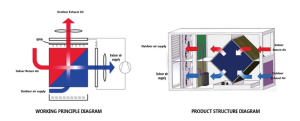Устройства косвенного испарительного охлаждения (КИО) все чаще используются в электрические щитовые комнаты, диспетчерские, и корпуса оборудования Для обеспечения энергоэффективного охлаждения без повышения влажности. В таких помещениях обычно размещается чувствительное электрическое и электронное оборудование, которое выделяет тепло во время работы и для надёжной работы которого требуется контролируемая температура.

Применение установок косвенного испарительного охлаждения в панельных помещениях
Как это работает
Система косвенного испарительного охлаждения охлаждает воздух без прямого контакта воды с воздухом в помещении. Вместо этого используется теплообменник для передачи тепла от тёплого воздуха внутри помещения к вторичному потоку воздуха, охлаждаемому за счёт испарения. Этот процесс обеспечивает:
-
Нет влаги входит в комнату управления.
-
The воздух внутри остается чистым и сухим.
-
Потребление энергии значительно ниже чем традиционное механическое охлаждение.
Преимущества применения в распределительных шкафах
-
Охлаждение без влаги:
Поскольку прямого контакта с водой не происходит, чувствительные электрические компоненты защищены от риска образования конденсата и коррозии.
-
Энергоэффективность:
По сравнению с традиционными системами кондиционирования воздуха блоки IEC потребляют меньше электроэнергии, что делает их идеальными для непрерывной работы в промышленных условиях.
-
Сокращение затрат на техническое обслуживание:
Благодаря меньшему количеству механических компонентов и отсутствию холодильного цикла система проста в обслуживании и имеет более длительный срок эксплуатации.
-
Повышенная надежность:
Поддержание стабильной и прохладной среды помогает продлить срок службы панелей управления и снижает риск выхода оборудования из строя из-за перегрева.
-
Экологически чистый:
Хладагенты не используются, что снижает воздействие системы на окружающую среду.
Типичные области применения
-
Электрощитовые на заводах
-
Шкафы управления серверами и сетями
-
Комнаты с инверторами или ПЛК (программируемым логическим контроллером)
-
Уличные телекоммуникационные корпуса
-
диспетчерские подстанции